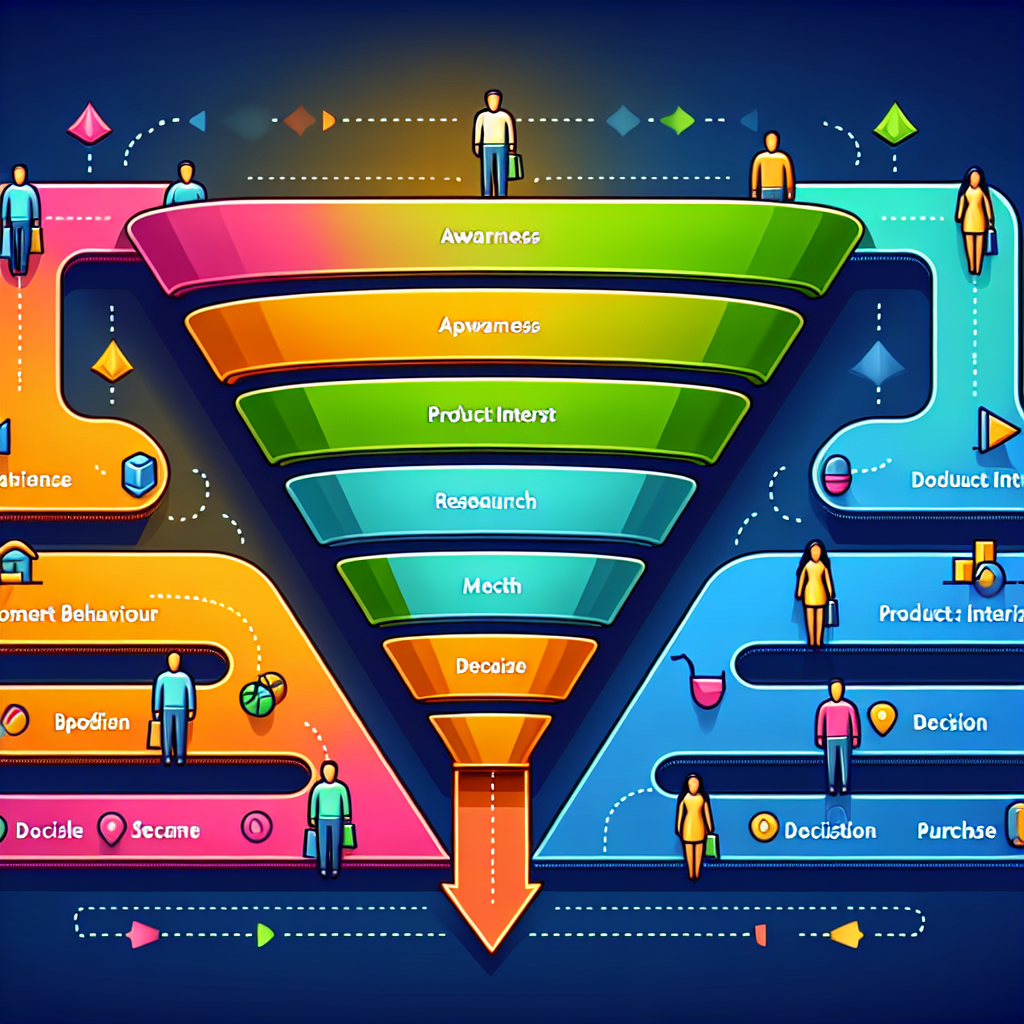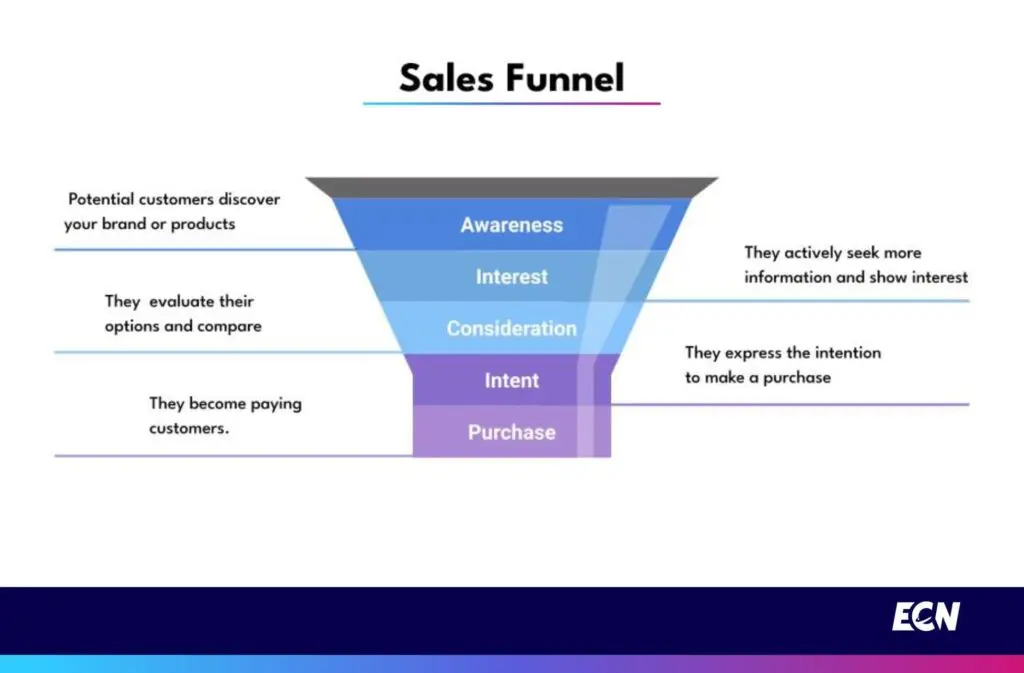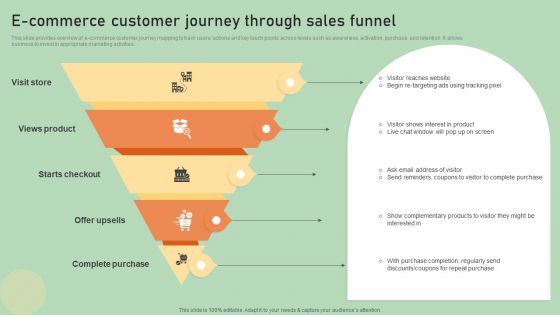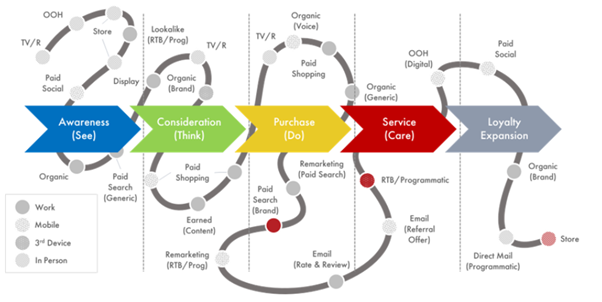Unlock the secrets to guiding customers seamlessly through your ecommerce funnel and watch your sales skyrocket like never before.

Image courtesy of via DALL-E 3
Table of Contents
- Introduction to Ecommerce Funnels
- Stages of an Ecommerce Funnel
- Creating an Effective Awareness Stage
- Strengthening the Consideration Stage
- Optimizing the Conversion Stage
- Retention: Keeping Your Customers Happy
- Analyzing Your Ecommerce Funnel
- Tools to Help With Ecommerce Funnels
- Summary
- Frequently Asked Questions (FAQs)
Introduction to Ecommerce Funnels
Welcome to the world of ecommerce funnels! In this digital age, online shopping has become a prevalent way for people to buy products and services. Now, imagine a virtual pathway that guides customers from just hearing about a product to actually making a purchase. That’s what an ecommerce funnel does. It’s like a roadmap that helps businesses lead potential buyers through the journey of purchasing something online. Let’s delve deeper into what ecommerce funnels are and why they are crucial for online shops.
What is an Ecommerce Funnel?
An ecommerce funnel is essentially a series of steps or stages that customers go through when they interact with a website or online store. Think of it as the process from the moment someone discovers a product to the point where they decide to make a purchase. Each stage in the funnel plays a specific role in guiding customers closer to becoming buyers.
Why Are Ecommerce Funnels Important?
Understanding and creating a well-designed ecommerce funnel is vital for sellers looking to boost their sales and provide a seamless shopping experience for customers. By guiding potential buyers through each stage of the funnel, businesses can increase conversions, build trust with customers, and ultimately grow their online presence.
Stages of an Ecommerce Funnel
In the world of online shopping, an ecommerce funnel plays a crucial role in guiding potential customers through the buying process. Understanding the different stages of an ecommerce funnel can help sellers effectively attract, engage, and convert visitors into loyal customers. Let’s take a closer look at the key stages that make up an ecommerce funnel.
Awareness Stage
At the awareness stage of an ecommerce funnel, individuals first become aware of a product or brand. This is where sellers grab the attention of potential customers through various marketing techniques, such as social media advertising, influencer partnerships, or content marketing. By creating a strong presence and generating interest, sellers can start building relationships with potential customers.
Consideration Stage
Once individuals are aware of a product, they move into the consideration stage of the funnel. Here, customers evaluate the product, compare it to other options, and weigh the benefits of making a purchase. To strengthen the consideration stage, sellers can provide detailed product information, offer comparisons with similar products, and showcase customer reviews and testimonials. This helps potential customers make informed decisions and feel confident in their choice.
Conversion Stage
The conversion stage is where the magic happens – it’s when potential customers turn into actual buyers. At this stage, customers decide to make a purchase and complete the transaction. To optimize the conversion stage, sellers should focus on providing a seamless and user-friendly checkout process, offering multiple payment options, and eliminating any obstacles that may deter customers from completing their purchase. By simplifying the buying process, sellers can increase the likelihood of conversion and drive sales.
Creating an Effective Awareness Stage
When it comes to guiding your customers towards making a purchase on your ecommerce platform, the first step is creating a strong awareness stage. This initial phase is crucial as it is where potential customers first learn about your brand and products. By effectively engaging shoppers at this stage, you can increase the likelihood of conversions down the line. Let’s explore some strategies to make your awareness stage impactful and engaging for your audience.

Image courtesy of www.ecommerce-nation.com via Google Images
Using Social Media
Social media platforms such as Instagram, Facebook, and Twitter are powerful tools for attracting attention to your products. By posting visually appealing content, engaging with your audience, and running targeted ads, you can effectively reach a wide range of potential customers. Utilize these platforms to showcase your products, share valuable content, and interact with your audience to build brand awareness and drive traffic to your ecommerce site.
Content Marketing
Content marketing plays a significant role in educating consumers about your brand and products. By creating valuable and relevant content such as blog posts, videos, and infographics, you can establish your expertise in your industry and provide helpful information to your audience. Share engaging stories, product tutorials, and user-generated content to connect with your target market and develop a loyal following. Consistent and high-quality content can help build trust with potential customers and keep them coming back for more.
Strengthening the Consideration Stage
When you’re trying to decide which toy to buy, have you ever looked at two options side by side to see which one suits you best? That’s what product comparisons in the consideration stage are all about! By showing you how different toys stack up against each other, sellers help you make smart choices. Do you want a remote-controlled car that goes super fast, or a robot that can dance? Comparing products can help you figure that out!
Customer Reviews
Imagine you’re thinking about getting a new video game. Wouldn’t it be cool if you could hear from other kids who’ve already played it? Customer reviews and testimonials do just that! They let you know what other players thought about the game. Maybe some found it super exciting, while others thought it was just okay. Reading these reviews can help you decide if that game is the right one for you. It’s like getting advice from friends who’ve already tried something!
Optimizing the Conversion Stage
When customers reach the conversion stage in an ecommerce funnel, they are ready to make a purchase. This is the critical moment where all the previous stages finally pay off, and a potential lead becomes a customer. Optimizing this stage is key to ensuring a smooth and successful buying experience. Here are some essential tips to help businesses maximize conversions:

Image courtesy of www.slidegeeks.com via Google Images
Simplify Checkout Process
One of the biggest reasons for cart abandonment is a complex and time-consuming checkout process. Make sure that the checkout page is simple, user-friendly, and requires minimal information from the customer. Avoid unnecessary steps, such as account creation, and provide clear instructions on how to complete the purchase. The goal is to make it as easy as possible for customers to buy the product.
Provide Multiple Payment Options
Not everyone prefers to pay in the same way. By offering multiple payment options, such as credit card, PayPal, Apple Pay, or even installment plans, businesses cater to a broader audience and reduce barriers to purchase. Ensure that the payment options are secure, reliable, and convenient for customers. Giving them flexibility in how they pay can increase the likelihood of completing the transaction.
Retention: Keeping Your Customers Happy
In the world of online shopping, it’s not just about getting customers to make a one-time purchase. It’s also about keeping them coming back for more. Once a customer has made their first purchase, it’s important to focus on retention strategies to ensure they remain satisfied and loyal. Let’s explore some key ways to keep your customers happy and coming back for more.
Excellent Customer Service
One of the most critical factors in retaining customers is providing excellent customer service. When a customer feels valued and taken care of, they are more likely to return to your store. Make sure to respond promptly to any inquiries or issues they may have, and go above and beyond to exceed their expectations. By providing top-notch customer service, you can turn first-time buyers into loyal customers who will keep coming back for more.
Follow-Up Emails
Another effective way to keep customers engaged and appreciated is through follow-up emails. After a customer has made a purchase, sending a thank you email or requesting feedback can make a big impact. This shows customers that you value their opinion and care about their experience with your store. Additionally, sending personalized recommendations based on their previous purchases can help keep them interested in your products and coming back for more.
Analyzing Your Ecommerce Funnel
When you have set up your ecommerce funnel, it is crucial to monitor its performance and make necessary improvements to enhance the customer journey and boost sales. By analyzing the data and metrics, you can gain valuable insights into how customers interact with your website and where there may be opportunities for optimization.

Image courtesy of corvidae.ai via Google Images
Monitoring Metrics
One of the key aspects of analyzing your ecommerce funnel is keeping track of important metrics that provide you with information on customer behavior. Conversion rates, which indicate the percentage of visitors who make a purchase, are essential to monitor. A high conversion rate signifies that your funnel is effective in guiding customers through the buying process. On the other hand, bounce rates, which show the percentage of visitors who leave the site without taking any action, can help identify where customers may be dropping off.
Making Improvements
Once you have collected data on various metrics, it is important to use this information to make informed decisions on how to improve your ecommerce funnel. By identifying weak points in the funnel where customers may be getting stuck or dropping off, you can implement changes to streamline the process and make it more user-friendly. This could involve simplifying the checkout process, optimizing product pages for better conversions, or adjusting your marketing strategies to better target potential customers.
Tools to Help With Ecommerce Funnels
In order to effectively create and analyze ecommerce funnels, there are various tools and software available to assist online shop owners. These tools can help in understanding customer behavior, tracking metrics, and optimizing the sales process. Here are some essential tools that can aid in this process:
Analytics Tools
Analytics tools play a crucial role in understanding how customers interact with your website and where they may encounter obstacles in the buying process. One of the most popular analytics tools is Google Analytics, which provides in-depth insights into website traffic, audience behavior, and conversion rates. By analyzing this data, online retailers can make informed decisions to optimize their ecommerce funnels for better sales performance.
Marketing Software
Marketing software can streamline various aspects of your ecommerce funnel, from email campaigns to social media promotions. Platforms like Mailchimp or HubSpot offer email marketing tools that help create personalized campaigns to engage customers at different stages of the funnel. Additionally, social media management tools like Hootsuite or Buffer can help schedule posts and track engagement to drive traffic to your online store.
Summary
In this article, we delved into the essential aspects of eCommerce funnels. We started with an explanation of what an eCommerce funnel is and why it is crucial for online shops. An eCommerce funnel is the journey customers take on a website from discovering a product to making a purchase. Understanding and creating a strong funnel can significantly boost sales and enhance customer satisfaction.

Image courtesy of www.wix.com via Google Images
Stages of an Ecommerce Funnel
Breaking down the stages of an eCommerce funnel, we discussed the Awareness Stage, Consideration Stage, and Conversion Stage. The Awareness Stage is when customers first learn about a product or brand, while the Consideration Stage involves comparing options before making a decision. Finally, the Conversion Stage is where customers make the purchase.
Creating an Effective Awareness Stage
To strengthen the Awareness Stage, we explored using social media platforms like Instagram and Facebook, as well as content marketing through blog posts and videos to attract potential customers.
Strengthening the Consideration Stage
Strategies such as providing product comparisons and highlighting customer reviews and testimonials were discussed to make customers more interested in purchasing the product.
Optimizing the Conversion Stage
Tips on simplifying the checkout process and offering multiple payment options were provided to make it easier for customers to complete their purchase.
Retention: Keeping Your Customers Happy
Retaining customers after their first purchase involves excellent customer service and follow-up emails to keep them engaged and appreciated.
Analyzing Your Ecommerce Funnel
We guided on how to analyze key metrics like conversion rates and bounce rates to make improvements that enhance the funnel’s performance.
Tools to Help With Ecommerce Funnels
Introducing various tools and software such as analytics tools like Google Analytics and marketing software to aid in creating and analyzing eCommerce funnels.
Want to turn these SEO insights into real results? Seorocket is an all-in-one AI SEO solution that uses the power of AI to analyze your competition and craft high-ranking content.
Seorocket offers a suite of powerful tools, including a Keyword Researcher to find the most profitable keywords, an AI Writer to generate unique and Google-friendly content, and an Automatic Publisher to schedule and publish your content directly to your website. Plus, you’ll get real-time performance tracking so you can see exactly what’s working and make adjustments as needed.
Stop just reading about SEO – take action with Seorocket and skyrocket your search rankings today. Sign up for a free trial and see the difference Seorocket can make for your website!
Frequently Asked Questions (FAQs)
What is an Ecommerce Funnel?
An ecommerce funnel is like a path that customers follow on a website from the moment they first discover a product to the point where they make a purchase. It involves different stages such as awareness, consideration, and conversion, guiding potential buyers through the buying process.
How Can I Improve My Ecommerce Funnel?
Improving your ecommerce funnel involves identifying any weak points in the customer journey and taking steps to enhance them. Here are a few tips to help you optimize your funnel:
1. Monitor Key Metrics: Keep an eye on important data points such as conversion rates, bounce rates, and popular products to understand where customers may be dropping off.
2. Enhance User Experience: Make sure your website is easy to navigate, load times are fast, and the checkout process is streamlined to reduce friction for buyers.
3. Personalize Customer Interactions: Tailor your marketing efforts and product recommendations to suit the preferences and behaviors of your target audience for a more tailored experience.
4. Implement A/B Testing: Experiment with different marketing strategies, product placements, and messaging to see what resonates best with your customers and drives more conversions.
5. Leverage Customer Feedback: Encourage reviews, testimonials, and feedback from customers to understand their needs better and address any pain points in the buying process.







